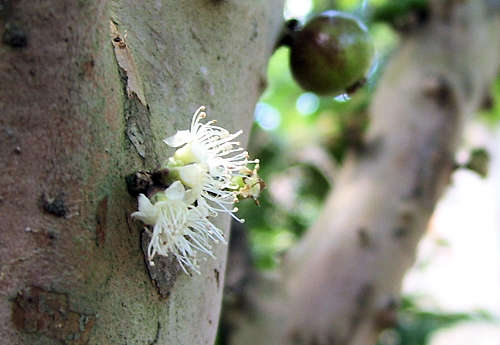Growing Jaboticaba:
Plinia cauliflora
Back to Fruit, Berries and Nuts
Botanical Overview
A member of the Myrtle family (Myrtaceae), the Plinia genus contains 69 tropical species worldwide. Plinia cauliflora, Jaboticaba, is one of the most well known due to the striking appearance of dark, grape-like fruit growing directly from its trunks and older branches.
Description
Form:
A multi-branched large shrub or small tree.
Lifespan:
150 years.
Leaf retention:
Evergreen.
Growth rate:
Slow.
Mature Size:
10-30' (3-9m) high and as wide, but it usually does not exceed 15' (4.5m) in temperate
regions.
Flowers:
Small, white, in clusters of three or four, with many long, yellow-tipped stamens, growing
directly on trunks and older branches.
Bloom:
One to five times a year depending on climate and irrigation. In temperate regions, blooming
usually occurs no more than three times a year. Consistently moist soil produces the most
blooms.
Self-fruitful:
Yes, but cross pollination with another plant greatly enhances yield.
Years before fruiting:
3 grafted, 4 layered, 6-10 from seed.
Fruit:
Grape-like, with a thick, tough, purple-black, astringent skin covering a sweet, white to
pink, gelatinous pulp containing one to four seeds.
Months for fruit to ripen:
20-25 days. The fruit are ripe when they are fully colored and slightly soft to the touch.
They should be harvested within one or two days of becoming ripe. A mature tree can produce
100 pounds (45.4kg) of fruit in one year.
Storage after harvest:
The fruit begin to ferment 2-4 days after harvest and should be consumed or processed
immediately. The skin is usually discarded.
Leaves:
Lance-shaped to oval, pinkish-yellow when new, changing to green and leathery.
Stems:
Densely branched, without thorns. The thin, reddish to brown bark flakes off easily and
lends the tree an attractive appearance.
Roots:
Fibrous, not invasive.
Wildlife:
The flowers attract pollinating insects. The fruit attracts birds and mammals.
Toxic / Danger:
The fruit skin is high in tannin and should not be consumed in large amounts.
Origin:
Brazil.
Cultivation and Uses
USDA hardiness zones:
10-12. Mature trees can withstand 26°F (-3.3°C).
Seedlings and young trees must be protected from freezing.
Chill hours:
None.
Heat tolerant:
This plant may need part shade most of the day above 100°F (38°C).
Drought tolerant:
Mature trees have moderate drought tolerance.
Sun:
Full sun to part shade, especially afternoon shade.
Planting:
In regions with summers over 100°F (38°C), locate this tree where it will receive
part to full shade most of the day, and full afternoon shade.
It is easily grown in a container and is often used in bonsai.
Soil:
Well draining, moderate to high organic content. While pH 5.6-6.5 (acidic to slightly acidic)
soil produces the best results, this plant tolerates neutral to slightly alkaline soil with
extra nutrient application.
Fertilize:
Apply organic fertilizer every month from mid-February to late September on soils that are
pH 6.6 (neutral) or higher.
Water after becoming established:
basin or flood irrigate every week or two during
the growing season. Reduce irrigation to every three or four weeks outside the growing season.
Mulch:
Spread organic mulch under the canopy and 8" (21cm) away from the trunk to reduce moisture
evaporation and protect the roots from temperature extremes.
First Three Years' Care:
Young plants are tropical understory trees and need all day part to full shade, especially
in hot months; they must be protected from freezes; and the soil should be watered frequently
and mulched to stay moist.
Prune:
This plant can be easily pruned as a hedge without reducing the fruit crop.
To grow as a tree, remove the lowest branches. Flowers and fruit appear on old wood.
Thinning the fruit when they are small and green by half results in the remaining fruit
growing larger.
Litter:
The fruit are messy if not harvested before they drop. Leaf drop occurs at certain times of
the year after heavy rains.
Propagation:
Cuttings grafted onto seedling rootstock and air layering are very successful.
Fresh seed may germinate in 20-40 days in slightly moist soil sealed in a plastic bag, one
or two seeds per bag. The soil should be high in organic material with mycorrhizal fungi.
The bag should be placed in an area that receives indirect sunlight.
Dried seed is not viable.
Uses:
Edible fruit, ornamental, bonsai. The fruit is used to make jams, jellies, juice and wine,
or is eaten raw.
Comments
This tree is also known as Jabuticaba and the Brazilian Grape Tree.
Do you have additional information or a different experience for these plants that you would like to share? Email info@GardenOracle.com. All contributions are welcome and appreciated.
Do you have additional information or a different experience for these plants that you would like to share? Email info@GardenOracle.com. All contributions are welcome and appreciated.



Latest update: August, 2024
© 2008-2025 by GardenOracle.com

